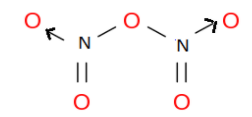Question
Question: The bonds present in \({{\text{N}}_{2}}{{\text{O}}_{5}}\) are: A. Ionic B. Covalent and coordina...
The bonds present in N2O5 are:
A. Ionic
B. Covalent and coordinate
C. Covalent
D. Ionic and covalent
Solution
The formation of bond take place by several methods such as ionic bond in which the complete transfer of electrons take place and a covalent bond is a bond which is formed by the sharing of the electrons and coordinate bond is the bond in which one element shares both the electrons.
Complete answer:
Ionic bonds are formed between the metals and non-metals because the loss of an electron from an atom and gain of an electron by another atom takes place.
Whereas in the covalent bond, the bond is formed between two metals and the equal sharing of electrons by both the elements take place.
As we know that both nitrogen and oxygen are metals, so there are four covalent bonds present in nitrogen pentoxide.
Moreover, we know that nitrogen can make three bonds as according to the electronic configuration of nitrogen (1s2 2s2 2p3) there are three valence electrons in the outermost shell of the nitrogen.
Also, nitrogen has a lone pair which does not participate in the bond formation and can be shared when needed and forms the coordinate bond.
So, in nitrogen pentoxide, the structure includes four covalent bonds and one coordinate bond.
The structure of nitrogen pentoxide is:

Here, the arrow represents the coordinate bond through which nitrogen shares a lone pair to the oxygen to fully fill its octet.
Therefore, option B is the correct answer.
Note: Generally non-metals form covalent bonds and metals form ionic bonds because they lose their electrons easily. Coordinate bond is also a type of covalent bond but here the electron comes from the same atom.
